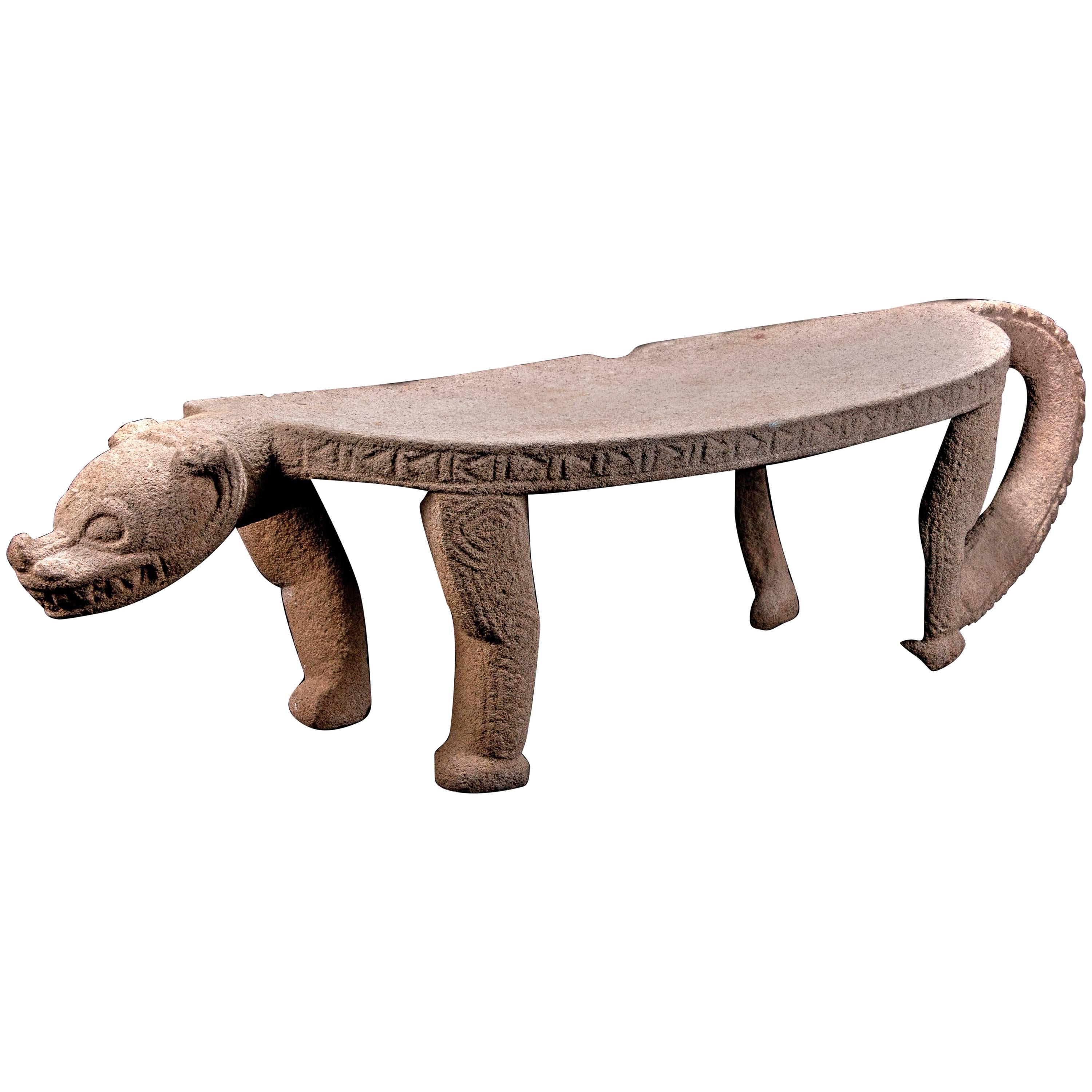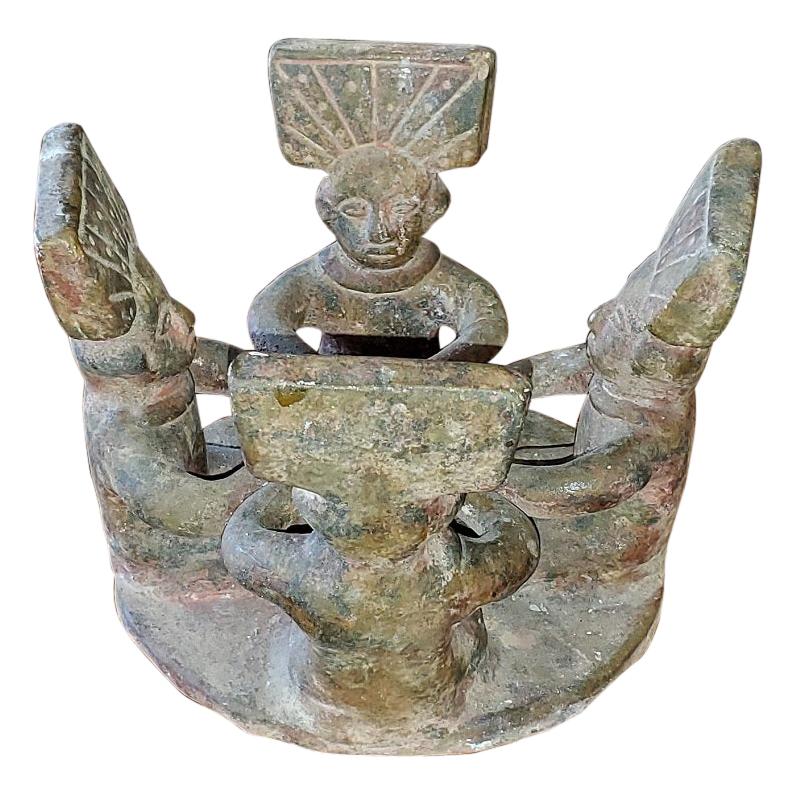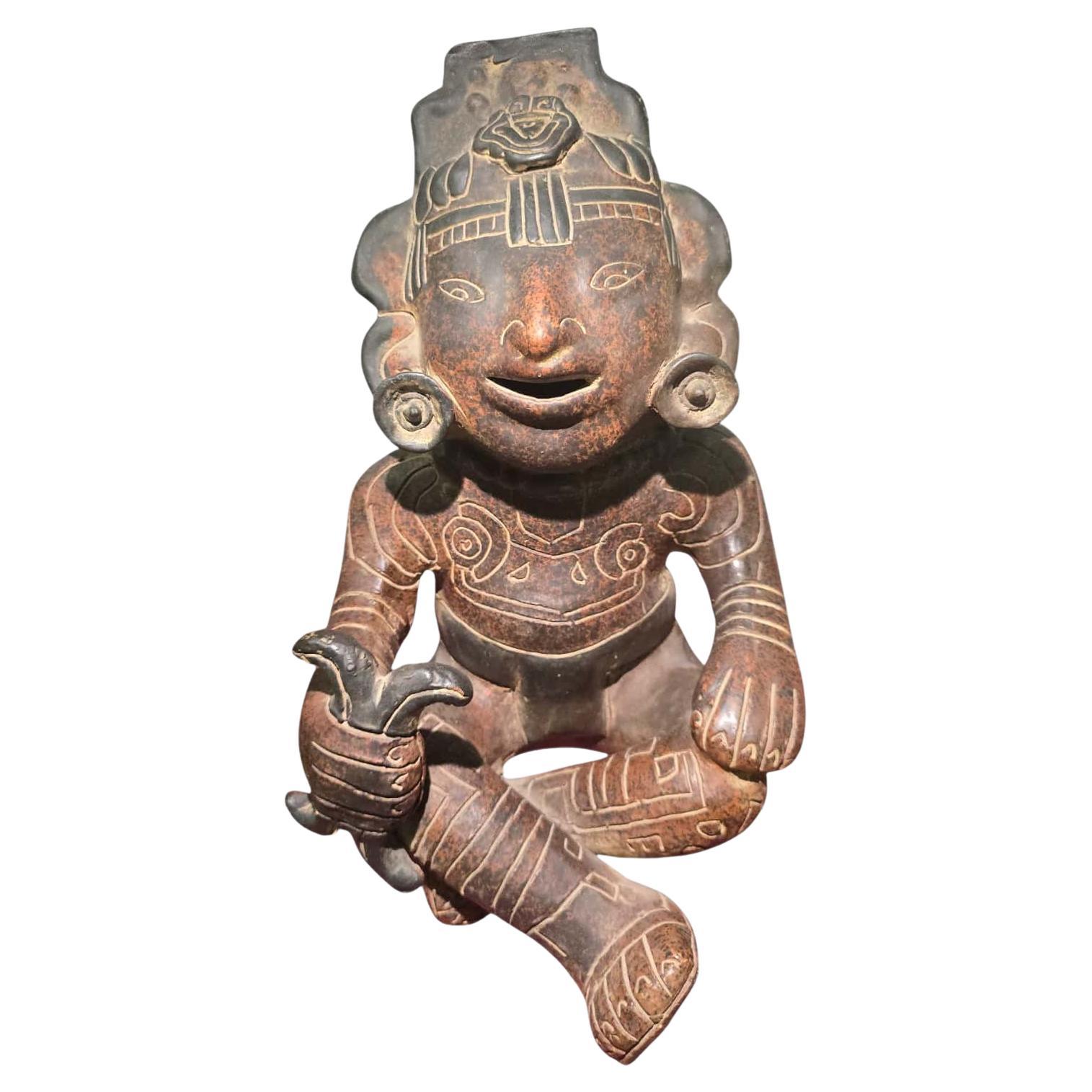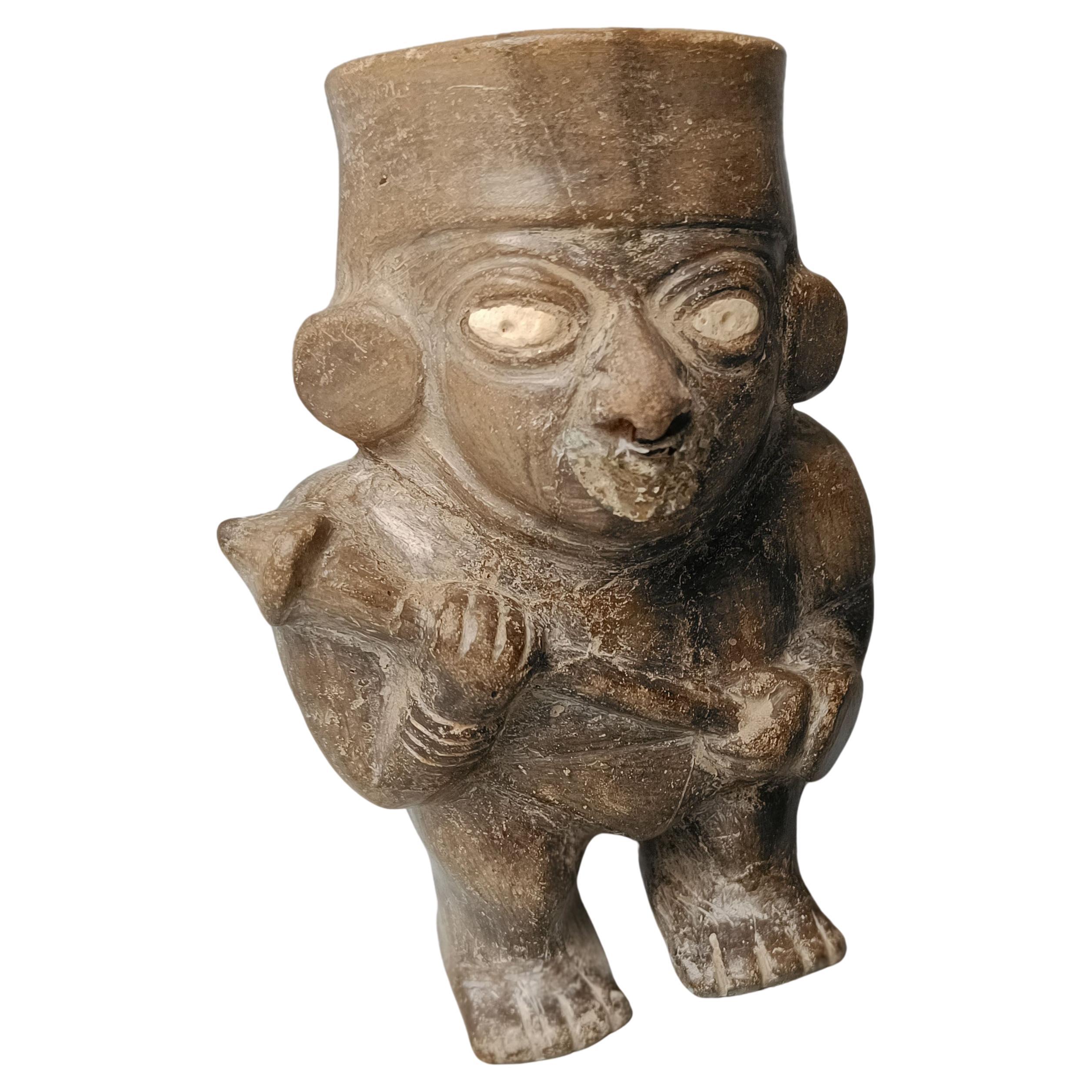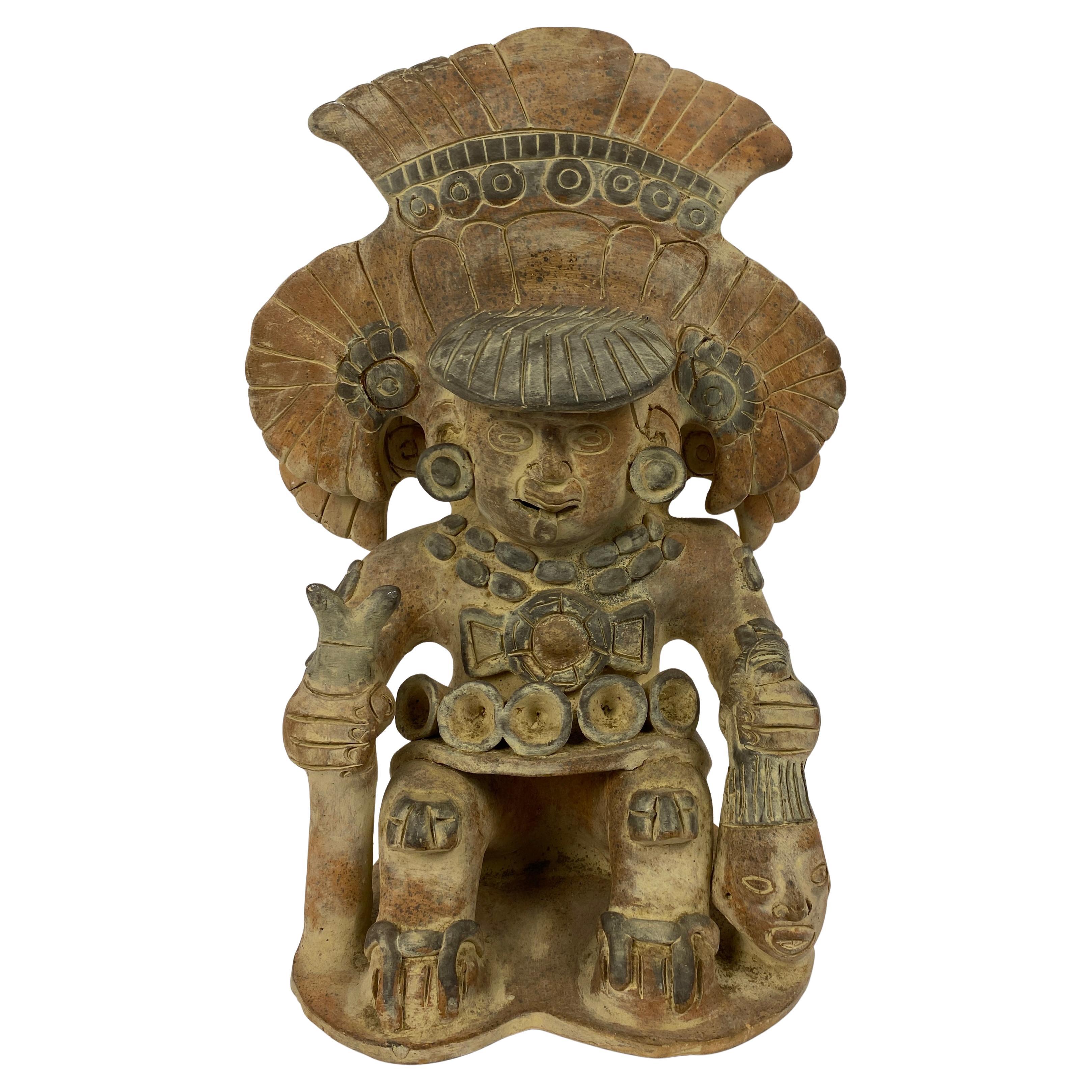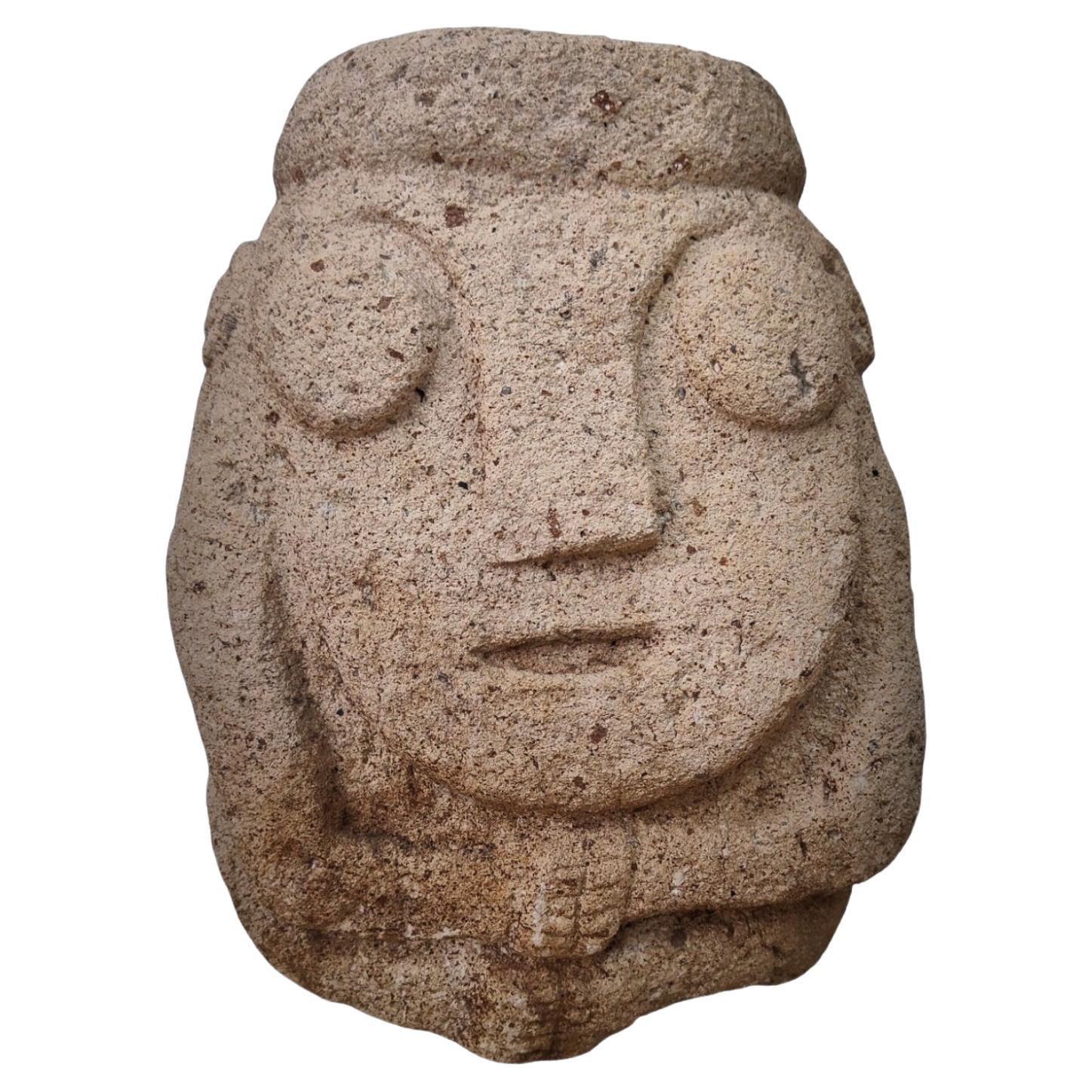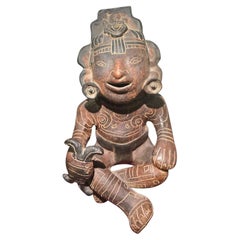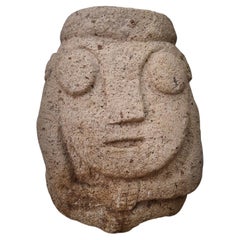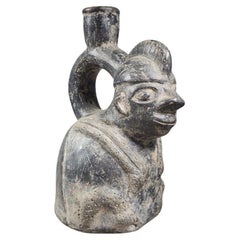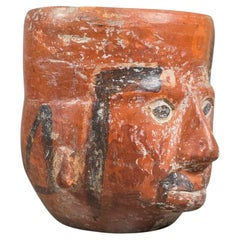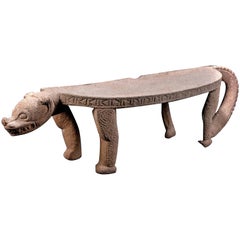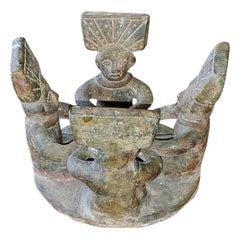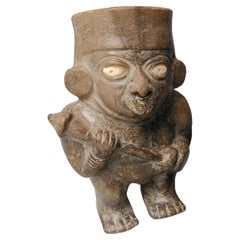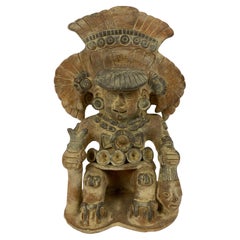Items Similar to Manteña Chair of Power Cachique of Prehispanic Ecuador 900 AD
Want more images or videos?
Request additional images or videos from the seller
1 of 17
Manteña Chair of Power Cachique of Prehispanic Ecuador 900 AD
$58,048.12
£42,819.43
€48,500
CA$80,428.57
A$87,329.80
CHF 46,247.52
MX$1,070,413.12
NOK 572,331.23
SEK 540,822.71
DKK 369,223.77
About the Item
MANTEÑA CHAIR OF POWER CACHIQUE OF PREHISPANIC ECUADOR
The chair has been carved from a block of
detrital sedimentary rock, in which fossil remains can be seen. It is a calcarenite or
dark brownish-yellow, porous, coarse-grained calcareous sandstone.
These stone chairs are usually classified according to the iconographic motif carved in
the support of the seat, dividing mainly into two groups, anthropomorphic and zoomorphic
–or zooanthropomorphic, since they represent variations that combine animal traits, generally felines, with the human being– Our chair corresponds to the second type, with a pedestal in the shape of a zoomorphic feline.
The feline is represented crouching, flexing arms and legs knees and elbows. The upper part of the chair – the ‘U’ shaped seat – is superimposed on the
back, head and shoulders of the figure. The way to place the seat on the full body
marks the difference between this specimen and others also anthropomorphic, in which said seat is
load only on the head, arranging an intermediate padding element carved between
the seat and back of the figure. As a consequence, in this case the head remains embedded and
sunk between two powerful shoulders that protrude with rounded shapes at the same height
than that one
In these sculptures, more attention has been paid to the face than to the rest of the morphology.
of the body, so the figure does not usually keep anatomical proportionality. does not seem to exist
nor is it a stable rule when it comes to placing the seat on the figure, some are more
back than others on the back of the character that supports it, and the depth of the seat is also
quite variable. Of course, what characterizes the seat is the 'U' shape, and that most of
the chairs have horizontal lateral extensions at the ends of these arms,
forming a right angle. These extensions have been interpreted as armrests. In general,
In addition, the shape of the 'U' is wider at the base and narrows towards the upper end,
as can be seen in the profile of this chair
The chairs in the context of the Manteño-Huancavilca culture
The Manteño-Huancavilca culture developed on the south-central coast of Ecuador, between the Bay of
Caráquez and the island of Puná10, during the Integration period . Saville to
early 20th century, Jijón y Caamaño (1997), Bushnell (1951) or Emilio Estrada (1957, 1962), among
others, are outlining through some initial archaeological excavations the features that define
to this culture. In it, two groups are differentiated, the manteños to the north and the huancavilcas to the south,
with certain common cultural traits and other particular or differentiating ones. And among the latter
precisely the use of carved stone as a feature of the Manteños stands out -the group
from the north–, to whom therefore the so-called chairs belong. To this could be added
characteristic of the north the iconography of the feline, the abundance of figurines and graters or the burial
compared to burial in urns, more typical of the huancavilcas.
As suggested by McEwan , the chairs with feline images correspond to religious power.
Title: Chair of power.
Object: Ceremonial chair carved in sandstone, with a 'U'-shaped seat, supported by a crouching ZOOMORPHIC figure.
Typology: Lithic sculpture.
Culture: Manteña (Manabi, Ecuador).
Dimensions: 38X38X20CM
Technique: Carving on stone block, sawn with cord.
Material: Mixed sandstone, of medium and coarse sand, with inclusions of bioclast shells
Use/Function: Ritual, ceremonial.
Provenance: Collection Dr. Professor: Udo Oberem
(1923-1986)
On November 24, 1986, Udo Oberem died suddenly and unexpectedly in Bonn, just before his 63rd birthday. The deceased was a number professor of ethnology — with special regard for
Americanist studies („Alt-Amerikanistik") - at the Faculty of Philosophy of the University of Bonn and director of the Institute of Anthropology
Cultural.
Biography: Manteña chairs from pre-Hispanic Ecuador
Study, restoration and analysis of a chair
stone in the Museum of America
Andrés Gutiérrez Usillos (scientific editor)
Museum of America. Ministry of Education, Culture and Sport.
- Dimensions:Height: 14.97 in (38 cm)Width: 7.88 in (20 cm)Depth: 14.97 in (38 cm)
- Materials and Techniques:
- Period:
- Date of Manufacture:900
- Condition:
- Seller Location:Madrid, ES
- Reference Number:1stDibs: LU5779235226972
About the Seller
4.8
Platinum Seller
Premium sellers with a 4.7+ rating and 24-hour response times
Established in 2005
1stDibs seller since 2021
373 sales on 1stDibs
Typical response time: 1 hour
- ShippingRetrieving quote...Shipping from: Madrid, Spain
- Return Policy
Authenticity Guarantee
In the unlikely event there’s an issue with an item’s authenticity, contact us within 1 year for a full refund. DetailsMoney-Back Guarantee
If your item is not as described, is damaged in transit, or does not arrive, contact us within 7 days for a full refund. Details24-Hour Cancellation
You have a 24-hour grace period in which to reconsider your purchase, with no questions asked.Vetted Professional Sellers
Our world-class sellers must adhere to strict standards for service and quality, maintaining the integrity of our listings.Price-Match Guarantee
If you find that a seller listed the same item for a lower price elsewhere, we’ll match it.Trusted Global Delivery
Our best-in-class carrier network provides specialized shipping options worldwide, including custom delivery.More From This Seller
View AllLarge Decorative Pre-Columbian Style Figure – 20th Century
Located in Madrid, ES
Impressive Pre-Columbian style figure from the 20th century, crafted in homage to ancient Mesoamerican art. The piece showcases stylized facial features and traditional ornamentation...
Category
Vintage 1950s Figurative Sculptures
Materials
Terracotta
Stone Carved Anthropomorphic Sculpture From The Recuay Culture Peru 400bc-400ac
Located in Madrid, ES
ANTHROPOMORPHIC SCULPTURE CARVED IN STONE OF THE RECUAY CULTURE PERU 400BC-400AC
Recuay is an archaeological culture of Ancient Peru that developed in the Sierra of the current Peruvian department of Áncash between 200 AD. C. until 600 d. C. It corresponds to the stage called Regional Developments, it has also been called the Huaylas or Santa culture.
Like the other Early Intermediate cultures, little is known about this culture. The most accepted position is that it was an extension of the Chavin culture, after the influence of the "White on Red" style in the region. Regarding the political aspect of the recuay, there is a hypothesis that questions their autonomy and maintains that Recuay would be part of one of the many political units that made up the Moche state.
The recuay style, characterized by its ceramics and stone sculpture, was initially described by Eduard Seler in 1893, based on ceramic specimens brought to the Ethnographic Museum in Berlin by Mariano M. Macedo. Seler named this style of pottery Recuay, based on the report that these pieces had been found in the town of Recuay. Later studies showed that this characteristic pottery was not originally from Recuay but from Copa, near Carhuaz, for which reason the name change to that of this town was proposed. Eventually the name of Huaylas was used for this culture. In 1919 Julio C. Tello explored the area and recovered lithic sculptures and Recuay-type ceramics. In the 1960s Rafael Larco Hoyle proposed changing the names of Recuay and Copa to Santa, arguing that the Recuay style had originated in the coastal regions of the Santa Valley. However, the name Recuay has persisted.
Its chronology is also highly debatable. The time of its origin between 0 and 200 AD is discussed. C. and its end or collapse is commonly set to 600 d. C. probably caused by the invasion of the Huari conquerors.
It encompassed almost the entire Callejón de Huaylas, a narrow valley fed by the Santa River and enclosed between two mountain ranges, the Cordillera Blanca to the west and the Cordillera Negra to the east. Its influence extended to the east to the Marañón river basin and to the west to the upper parts of the Santa, Casma and Huarmey valleys. To the north it reached the town of Pashash, in the province of Pallasca.
The Copa area, Marca district, Recuay province, Ancash department seems to have been the center or main nucleus of cohesion of this culture. The name of the culture would then be justified, derived from the province of the same name. Other important settlements were those of Huilcahuaín (near the current city of Ancash), Cátac, Araucay, Tambo, Jancu, Upayacu and Pashash (near the current city of Cabana).
Its main form of expression of art was through stone work (carving and masonry), inherited from its predecessor, the Chavín culture. In addition, they made sculptures in lumps that represent warriors with shields or trophy heads, with which they decorated their complex architectural constructions. They also made white clay pottery...
Category
Antique 15th Century and Earlier Figurative Sculptures
Materials
Stone
Pre-Columbian Chavín vessel, 900 BC – 300 BC.
Located in Madrid, ES
Pre-Columbian vessel from the Chavín culture in the form of a seated man, probably a hunter, with an animal on his back.
Chavín art is known for its complex iconography and mythical ...
Category
Antique 15th Century and Earlier South American Tribal Ceramics
Materials
Earthenware
Pre-Columbian ceramics can– Tiahuanaco Culture
Located in Madrid, ES
"Pre-Columbian Ceramics – Tiahuanaco Culture"
Material: ceramics
Origin: Southern Sierra of Peru, Lake Titicaca Plateau
Period: Boom Age (1 AD – 800 AD)
Dimensions: 11 x 10 cm diamet...
Category
Antique 15th Century and Earlier South American Tribal Ceramics
Materials
Ceramic
Pre-Columbian ceramics vessel– Tiahuanaco Culture
Located in Madrid, ES
Pre-Columbian Ceremonial Vessel with Avian Motif, 24x17x20 cm
A captivating Pre-Columbian ceramic vessel featuring a pronounced avian head protuberance, likely symbolizing a bird of...
Category
Antique 15th Century and Earlier South American Tribal Ceramics
Materials
Ceramic
$1,160 / item
Pre-Columbian Zoomorphic Ceramic Vessel
Located in Madrid, ES
A striking Pre-Columbian ceramic vessel shaped in a zoomorphic form, likely representing a dog or similar sacred animal figure, characterized by its expressive, upward-facing open mo...
Category
Antique 15th Century and Earlier South American Tribal Ceramics
Materials
Ceramic
You May Also Like
Published Pre-Columbian Nicoya Ceremonial Stone Seat, Ex Arizona Museum
Located in San Pedro Garza Garcia, Nuevo Leon
Nicoya Ceremonial Basalt Stone Seat in Shape of a Jaguar. Published in the Arizona Museum.
This large and finely carved example of Costa Rican skill and craftsmanship is in the form of a jaguar which may have been a lineage or clan symbol - as also was the crocodile - according to 16th-century Spanish conquistadors. There are so many features that make this masterpiece so unique. The most realistic depiction is the face with its head captured in a pose that is threatening and fierce.
Sculptors in ancient Central America developed elaborate metate forms that were associated with high status and wealth. They were commonly placed within graves of prominent individuals. Certain ancient rituals must have incorporated this activity and required special metates to be created for this purpose. It may have also served as a throne for the ruler, for whom the assurance of the fertility of his land and people would have been paramount.
Even today, stone metates...
Category
Antique 15th Century and Earlier Pre-Columbian Animal Sculptures
Materials
Stone
Vintage Pre-Columbian Style Pottery Centerpiece
Located in Dallas, TX
PRESENTING a LOVELY piece of reproduction Native American Antiquity, namely, a Vintage Pre-Columbian Style Pottery Centerpiece.
We are of the opinion that this was made circa the ea...
Category
Early 20th Century Mexican Pre-Columbian Ceramics
Materials
Ceramic, Terracotta
Pre Columbian Rare Moche Warrior Vessel South Latin American Antiques Art
Located in London, GB
Pre-Columbian Moche Warrior Vessel – Moche V Period, 600–700 AD, Peru
A striking and rare example of Moche ceramic artistry, this Pre-Columbian greyware warrior vessel dates from th...
Category
Antique 15th Century and Earlier Peruvian Antiquities
Materials
Pottery
Pre-Columbian Style Mexican Terracotta Statue, Molded Clay Figurative Sculpture
Located in Miami, FL
Vintage, decorative and well-proportioned Mexican primitive figure depicting a man seated, with detailed, patterned clothing. The sculpture measures
16 1/4" High x 12" wide x 9 1/2"...
Category
20th Century Mexican Pre-Columbian Figurative Sculptures
Materials
Clay
$1,520 Sale Price
20% Off
Pre Columbian Jalisco Figure West Mexico Circa B.C. 100-300 A.D
Located in London, GB
A Pre Columbian Jalisco seated figure
Jalisco West Mexico circa B.C. 100-300 A.D,
A Male pottery figure with red slip with elongated head and linear delineated hair wearing ear and nose ornaments, the slim body finely modelled with hands on chest seated...
Category
Antique 15th Century and Earlier Mexican Antiquities
Materials
Pottery
Nayarit Chinesco-Style Figure
Located in Chicago, IL
This seated effigy figure was crafted in 300 BC to 300 AD from the ancient Nayarit region of Mexico and was likely used as a ritual or burial offering. The ceramic works of the Chine...
Category
Antique 15th Century and Earlier Mexican Pre-Columbian Figurative Sculpt...
Materials
Ceramic
More Ways To Browse
15th Century Stone Sculpture
Antique Anthropology
Crouching Figure
Antique Ecuador
Antique Chair Museum
Ceremonial Chair
Antique Ceremonial Chairs
Antique Graters
Pegasus Horse
Stone Dog
Swan Birds
Vintage Wood Monkey
Bronze Parrot
Bull Italy
Darren Ransdell Sculptures
Elephant Statue
French Animalier Sculpture
Hippo Vintage
